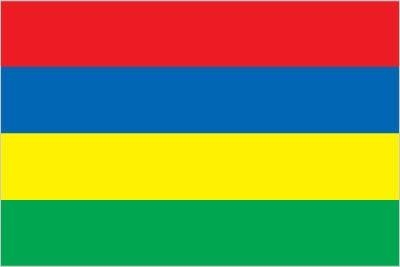210 Mauritius

Four equal horizontal bands of red (top), blue, yellow, and green. Red represents self-determination and independence, blue the Indian Ocean surrounding the island, yellow has been interpreted as the new light of independence, golden sunshine, or the bright future, and green can symbolize either agriculture or the lush vegetation of the island.
Flag courtesy of the CIA World Factbook

Map courtesy of the CIA World Factbook

A panoramic view of Mauritius Island
Government
According to Britannica, Mauritius became independent on March 12, 1968. Under the constitution adopted that year, the country was a constitutional monarchy with the British monarch as head of state. In 1991 a constitutional amendment was passed providing for a republican form of government, with a president as head of state; the amendment went into effect in 1992. Legislative power is vested in a National Assembly, elected every five years and consisting of 62 elected members and up to an additional 8 members drawn from the pool of candidates who were not elected but who may be appointed to broaden representation among minorities or underrepresented parties. Executive power is exercised by a Council of Ministers headed by a prime minister (appointed by the president), who assembles a government from members of the National Assembly. The president and vice president are elected by the National Assembly for a term of five years.
For administrative purposes, the island of Mauritius is divided into districts. The outlying territories of Agalega, Cargados Carajos Shoals, and Rodrigues Island each have dependency status.
The Supreme Court is the highest judicial authority and includes courts of civil appeal and criminal appeal. There are also district courts.
Mauritius Department of Civil Aviation (DCA)
The Mauritius Department of Civil Aviation (DCA) has the following functions:
Airspace
SkyVector – Google Maps – ADS-B Exchange
ICAO countries publish an Aeronautical Information Publication (AIP). This document is divided into three parts: General (GEN), En Route (ENR) and Aerodromes (AD). ENR 1.4 details the types of airspace classes they chose to adopt from classes A through G.
Drone Regulations
THE CIVIL AVIATION ACT Regulations made by the Minister under section 11 of · the Civil Aviation Act
mentions remotely piloted aircraft
MAURITIUS CIVIL AVIATION REQUIREMENTS
mentions remotely piloted aircraft
Mauritius Civil Airworthiness Requirements – Drone
Mauritius Government Gazette dated 2018-02-12 number 13
DCA Operations Manual Template
DCA – RPA – Application Form Version 01 – 2016
Notice to Remotely Pilot Aircraft Operators
REMOTELY PILOTED AIRCRAFT OPERATORS
Drone Risk Assessment and Special Permission Approval Guidance Material and Checklist – 2021
Advanced Air Mobility (AAM) Regulations & Policies
None found by the author.
However, should you, the reader, happen to stumble across something to the contrary, please email the author at FISHE5CA@erau.edu and you may be mentioned in the ACKNOWLEDGEMENTS section of this book by way of thanks for contributing to this free eBook!
Advanced Air Mobility (AAM) News
None found by the author.
However, should you, the reader, happen to stumble across something to the contrary, please email the author at FISHE5CA@erau.edu and you may be mentioned in the ACKNOWLEDGEMENTS section of this book by way of thanks for contributing to this free eBook!
Short Essay Questions
Scenario-Based Question
You have been hired by a Drone Startup Company. Your boss has immediately assigned this job to you.
They need you to prepare a one-page memo detailing the legalities of using a drone to film in Mauritius.
They need you to mention any national laws and local ordinances.
They specifically want to know what airspace (insert pictures) you will be operating in and whether or not you need an airspace authorization.
Does it matter whether or not you are a citizen of the country?
Lastly, there is a bonus for you if, as you scroll through this chapter, you find any typos or broken links!
Short Essay Questions
- What are the drone categories?
- How is registration addressed?
- How is remote ID addressed?
- What are the model aircraft rules?
- What are the commercial drone rules?
- Are there waivers or exemptions to the rules? If so, for what?
- Would you share a link to an interactive airspace map?
- How is BVLOS addressed?
- How can you fly drones at night?
- How can you fly drones over people?
- Where do you find drone NOTAMs?
- What are the rules for drone maintenance?
- What are the rules for an SMS program?
- What are some unique rules not mentioned above?
- What are the C-UAS rules?
- What are the AAM rules?

